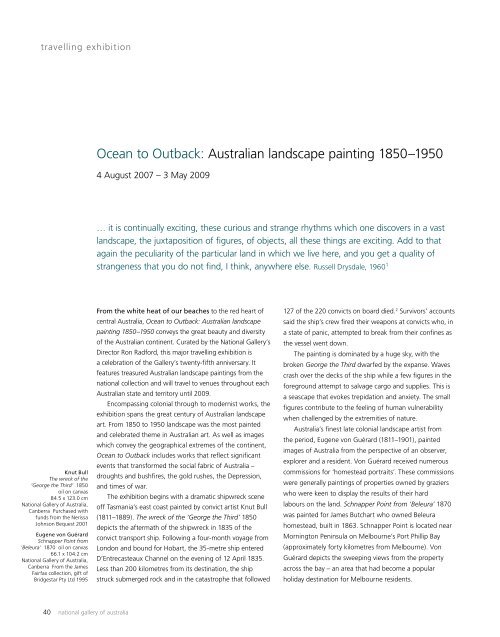Art Ew - National Gallery of Australia
Art Ew - National Gallery of Australia
Art Ew - National Gallery of Australia
Create successful ePaper yourself
Turn your PDF publications into a flip-book with our unique Google optimized e-Paper software.
travelling exhibition<br />
Knut Bull<br />
The wreck <strong>of</strong> the<br />
‘George the Third’ 1850<br />
oil on canvas<br />
84.5 x 123.0 cm<br />
<strong>National</strong> <strong>Gallery</strong> <strong>of</strong> <strong>Australia</strong>,<br />
Canberra Purchased with<br />
funds from the Nerissa<br />
Johnson Bequest 2001<br />
Eugene von Guérard<br />
Schnapper Point from<br />
‘Beleura’ 1870 oil on canvas<br />
66.1 x 104.2 cm<br />
<strong>National</strong> <strong>Gallery</strong> <strong>of</strong> <strong>Australia</strong>,<br />
Canberra From the James<br />
Fairfax collection, gift <strong>of</strong><br />
Bridgestar Pty Ltd 1995<br />
40 national gallery <strong>of</strong> australia<br />
Ocean to Outback: <strong>Australia</strong>n landscape painting 1850–1950<br />
4 August 2007 – 3 May 2009<br />
… it is continually exciting, these curious and strange rhythms which one discovers in a vast<br />
landscape, the juxtaposition <strong>of</strong> figures, <strong>of</strong> objects, all these things are exciting. Add to that<br />
again the peculiarity <strong>of</strong> the particular land in which we live here, and you get a quality <strong>of</strong><br />
strangeness that you do not find, I think, anywhere else. Russell Drysdale, 1960 1<br />
From the white heat <strong>of</strong> our beaches to the red heart <strong>of</strong><br />
central <strong>Australia</strong>, Ocean to Outback: <strong>Australia</strong>n landscape<br />
painting 1850–1950 conveys the great beauty and diversity<br />
<strong>of</strong> the <strong>Australia</strong>n continent. Curated by the <strong>National</strong> <strong>Gallery</strong>’s<br />
Director Ron Radford, this major travelling exhibition is<br />
a celebration <strong>of</strong> the <strong>Gallery</strong>’s twenty-fifth anniversary. It<br />
features treasured <strong>Australia</strong>n landscape paintings from the<br />
national collection and will travel to venues throughout each<br />
<strong>Australia</strong>n state and territory until 2009.<br />
Encompassing colonial through to modernist works, the<br />
exhibition spans the great century <strong>of</strong> <strong>Australia</strong>n landscape<br />
art. From 1850 to 1950 landscape was the most painted<br />
and celebrated theme in <strong>Australia</strong>n art. As well as images<br />
which convey the geographical extremes <strong>of</strong> the continent,<br />
Ocean to Outback includes works that reflect significant<br />
events that transformed the social fabric <strong>of</strong> <strong>Australia</strong> –<br />
droughts and bushfires, the gold rushes, the Depression,<br />
and times <strong>of</strong> war.<br />
The exhibition begins with a dramatic shipwreck scene<br />
<strong>of</strong>f Tasmania’s east coast painted by convict artist Knut Bull<br />
(1811–1889). The wreck <strong>of</strong> the ‘George the Third’ 1850<br />
depicts the aftermath <strong>of</strong> the shipwreck in 1835 <strong>of</strong> the<br />
convict transport ship. Following a four-month voyage from<br />
London and bound for Hobart, the 35-metre ship entered<br />
D’Entrecasteaux Channel on the evening <strong>of</strong> 12 April 1835.<br />
Less than 200 kilometres from its destination, the ship<br />
struck submerged rock and in the catastrophe that followed<br />
127 <strong>of</strong> the 220 convicts on board died. 2 Survivors’ accounts<br />
said the ship’s crew fired their weapons at convicts who, in<br />
a state <strong>of</strong> panic, attempted to break from their confines as<br />
the vessel went down.<br />
The painting is dominated by a huge sky, with the<br />
broken George the Third dwarfed by the expanse. Waves<br />
crash over the decks <strong>of</strong> the ship while a few figures in the<br />
foreground attempt to salvage cargo and supplies. This is<br />
a seascape that evokes trepidation and anxiety. The small<br />
figures contribute to the feeling <strong>of</strong> human vulnerability<br />
when challenged by the extremities <strong>of</strong> nature.<br />
<strong>Australia</strong>’s finest late colonial landscape artist from<br />
the period, Eugene von Guérard (1811–1901), painted<br />
images <strong>of</strong> <strong>Australia</strong> from the perspective <strong>of</strong> an observer,<br />
explorer and a resident. Von Guérard received numerous<br />
commissions for ‘homestead portraits’. These commissions<br />
were generally paintings <strong>of</strong> properties owned by graziers<br />
who were keen to display the results <strong>of</strong> their hard<br />
labours on the land. Schnapper Point from ‘Beleura’ 1870<br />
was painted for James Butchart who owned Beleura<br />
homestead, built in 1863. Schnapper Point is located near<br />
Mornington Peninsula on Melbourne’s Port Phillip Bay<br />
(approximately forty kilometres from Melbourne). Von<br />
Guérard depicts the sweeping views from the property<br />
across the bay – an area that had become a popular<br />
holiday destination for Melbourne residents.

















